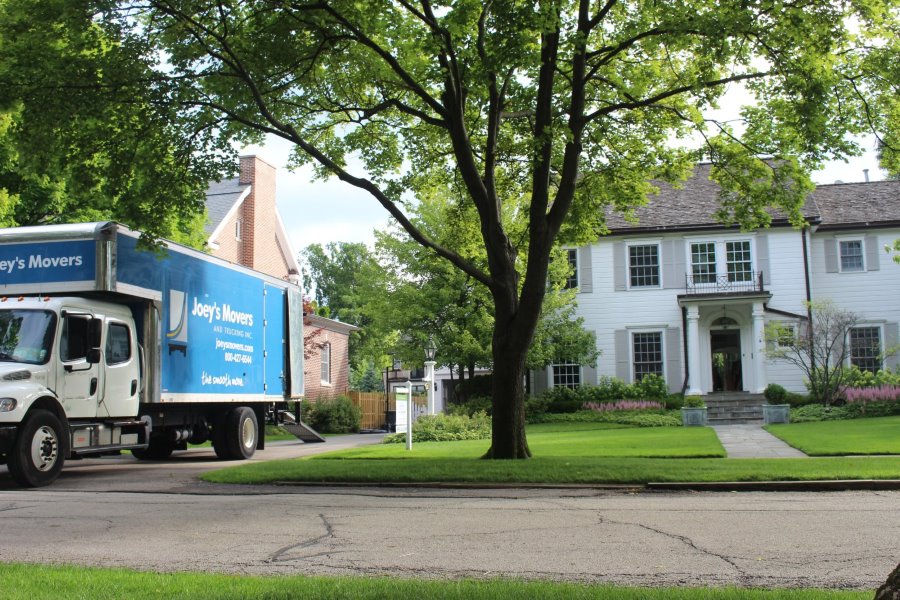Moving is expensive, but what if you’re paying more than you expected? Understanding how to avoid hidden moving costs is crucial to minimizing financial surprises and ensuring a smooth transition to your new home or work area.
In this guide, our experts provide a variety of common moving expenses and practical strategies to help you budget effectively. We’ll go over:
- How to avoid hidden moving costs
- Costs associated with moving out of state
- The true cost of moving
Whether you’re moving for work, buying your first home, or relocating to a new city, we will help you prepare for every possible cost to make your experience as smooth as possible! Coordinate your move with Joey’s Movers. We’ll give you accurate estimates. Call us today at (847) 674-7779, or get a free online quote.
The True Cost of Moving: What’s Included vs What’s Hidden
A moving quote often includes standard expenses like:
- Truck rental
- Labor costs
- Fuel charges
- Moving supplies (boxes, tape, packing materials)
However, the difference between the base price and the final cost can be significant. Many quotes don’t account for additional fees that arise due to logistics, accessibility issues, items that were not included in the packing estimate, or unexpected moving delays. Understanding these costs in advance can help you mitigate them and prevent sticker shock.
The Most Common Hidden Moving Costs and Fees
Moving expenses often extend beyond the initial quote, catching many people off guard. Being aware of these hidden charges helps you plan your budget and avoid unpleasant surprises on moving day.
Here are a few of the most common hidden moving costs that contribute to the true cost of moving.
Moving Company Fees That Add Up
- Long-Carry Fees. These fees apply when a moving vehicle can’t park close to your home. Movers must spend more time packing items into the vehicles, and items that require special handling may require extra equipment.
- Stair/Elevator Fees. If your move involves multiple flights of stairs or an elevator, this can limit how much they can move at a time, and various items need special handling to avoid damage or worker injury. Some companies charge per flight of stairs, while others have a flat fee.
- Shuttle Truck Fees. When the truck can’t access your location, a smaller truck (or “shuttle truck”) is used to ferry items between your home and the main vehicle. If this contingency is not planned beforehand, it can significantly raise rental, gas, and labor fees.
- Packing and Unpacking Fees. If your moving company offers packing and unpacking, they might charge a set rate or by the hour. If you have more stuff to pack than was anticipated in the quote, there could be significant extra fees from labor and supply costs..
- Heavy/Large/Fragile Item Fees. Speciality items like pianos, oversized furniture, gun safes, or collectors items require special equipment and tend to take more time. Movers typically charge an additional fee based on the weight and complexity of these items. If these are not included in the quote, they can add up to hefty surprise fees.
Hidden Costs When Moving to a New Home or State
- Utility Deposits and Setup Fees. Utilities and services like electricity, gas, water, and the internet require deposits and installation fees.
- Driver’s License and Vehicle Registration. If you move to another state, you will be legally required to update your state-issued tags, licenses, IDs, and registrations. The cost of transferring your state documents will vary, and it will be heavier if your license is expired.
Expired documents are another costly factor. If an expired license falls too far outside the state’s grace period, you may even be required to retake the driving exams and reapply for your licenses.
- Insurance Increases. Your homeowners, renters’, vehicle, and health insurance premiums are based on your location and the risk factors associated with the area, like flood zones or higher crime rates. Contacting companies before you move can give you time to negotiate your new rates and avoid sticker shock when the bills come in.
- Storage Costs. If your home isn’t move-in ready when you get there, you may need to temporarily store your belongings in a storage unit. Fees will depend on location, how much storage space you need, how long you need it, and factors like climate control or 24-hour access.
- Cleaning and Repair Fees. When you move in or out, you will incur cleaning costs either from suppliers or from hiring a third party. If you are renting, light cleaning and repairs may be covered under your deposit. However, if the cost of making it move-in ready exceeds the deposit, you may still be billed extra fees.
Travel and Temporary Living Costs
- Hotel and Living Expenses. When you’re relocating long-distance or over multiple days, budget for yourself. Overnight stays, meals, hygiene items, replacement chargers, and other living expenses can add up faster than you expect.
- Gas and Tolls. Fuel and tolls can chip away at your budget, especially if you underestimate how much travel fare you need. Busy travel seasons, fluctuating gas prices, surprise tolls, construction detours, and long traffic jams add up.
- Temporary Living. If your new home isn’t move-in ready when you get there, you might need unanticipated short-term housing like a hotel, Airbnb, or an extended-stay rental.
The true cost of moving extends far beyond the initial quote. It is a mix of moving costs, living expenses, and adapting to various setbacks.
How to Avoid Hidden Moving Costs: Money-Saving Strategies
Unexpected moving costs can put a strain on your budget, but with careful planning and strategic decision-making, you can minimize these expenses. Understanding how movers calculate fees and taking steps to reduce unnecessary add-ons can make a big difference. Below are key strategies to help you avoid hidden costs and keep your moving budget in check.
Is the Quote a Binding or Non-binding Estimate?
A binding estimate guarantees the price, but it is higher or limits how much the moving company can adapt to unexpected situations. A non-binding estimate is generally lower and more flexible, but the final cost may significantly increase or decrease based on actual weight and services.
A Detailed Inventory is Vital
If you forget a room or that some of your keepsakes need special handling, the costs can quickly exceed the quoted price. Providing an accurate inventory list helps movers give precise estimates and reduces the risk of surprise charges. Our packing tips can help you identify some overlooked areas, and our experts are more than happy to schedule a walk-through to give you the most accurate quote possible.
Key Questions to Ask Movers
- Are there additional fees for stairs, long carries, or special handling?
- What happens if the move takes longer than expected?
- Do you offer binding estimates to guarantee the price?
DIY Packing vs. Paying Movers
Depending on your time and resources, it might be more cost-efficient to pack your things yourself. Boxes from local stores and a few friends can make the process a lot easier. If you get overwhelmed, we’re always here to offer our packing and unpacking services on what’s left!
Protect Fragile Items
The cost of replacing fragile items can add up fast. Use appropriate packaging materials, like bubble wrap or thick protective cloths. Label fragile items with signs like “Fragile” and “This Side Up” so that movers handle them with the appropriate level of care.
In some cases, like with delicate glass collectibles or costly fine art, paying a fully licensed and insured moving company to pack them for you may save you money in the long run, as they can help avoid damages to your belongings.
Use Free Packing Materials
Grocery and furniture stores often have free boxes and loose packing material. Online groups like Nextdoor and Freecycle often offer free materials from others who recently moved. If you have to make online orders, keep the boxes and wrap. Every little bit counts!
Renting a Truck v. Full-Service Movers
Renting a truck from a moving company can be cheaper than hiring a full-service mover, but you’ll be expected to handle all the labor. This is great for small moves, tight budgets, or if you have plenty of helping hands. Ourfull-service team is always here if you start to feel overwhelmed, though!
Hybrid Solutions
Moving choices are not all or nothing. You can mix and match to reduce costs and find the right solutions for you. For example you can
- Rent a truck, but only hire labor as needed
- Hire packers, but provide your own packing supplies
- Have friends help you pack, but let movers pack extra large or fragile items.
Avoid Unnecessary Add-Ons
You do not want to underestimate what you need for a successful move, but you can save money by cutting out any services you know you don’t need.
- Don’t pay for full packing services if you only need half the services it provides
- Weigh whether you need convenience upgrades like extended insurance, expedited delivery, or specialized crates.
- Instead of adding a shuttle bus for unreachable locations, consider whether it is more cost-efficient for movers to deliver goods to an accessible storage area.
Unexpected Costs After Moving and How to Prepare
When we discussed the true costs of moving, we briefly discussed things like your state licenses and deposits, but there are other things to consider in the months after you move.
Utility Costs and Property Taxes
The cost of utilities and property taxes can vary significantly by location. You may also find that you have to pay for things that were either included in your old lease or that your old community did not charge for, like sewer and trash. Researching these expenses ahead of time helps you adjust your budget.
HOA Fees and Community Move-In Charges
Condos or gated communities sometimes charge move-in fees to residents. If your area has an HOA, your monthly or annual dues will be separate from your rent or mortgage. Reach out to these groups early on to acquaint yourself with any regulations. This will help you avoid hefty penalty fines from unintended violations early on.
Replacing Furniture or Appliances
Even with careful planning, it’s possible that some of your furniture will not fit the new space, layout, or color scheme. This will require you to find a place to store or donate them, plus the added cost of an appropriate replacement. Reducing unneeded furniture and appliances before you move will reduce your overall moving costs, and you may be able to find a secondhand or deeply discounted replacement with some research into the local area.
FAQ Section
What Are Some Unforeseen Costs in Moving?
Hidden fees include long-carry fees, stair or elevator fees, and shuttle truck costs. If the home is not move-in ready, you may need to pay extra short-term housing and storage costs. Gas, living expenses, utility deposits, and other necessities also add up to the true cost of moving.
How to Avoid Hidden Moving Costs?
Planning is key. Get a detailed, itemized inventory. Try to schedule moving services and rentals during off-peak hours. Research costs and regulations around your new home in advance. Make sure to communicate with your movers about what they charge for specific services and get an itemized quote. See if they can offer a binding quote and if it is the right call for your moving situation.
What Is the True Cost of Moving?
The true cost is always beyond the base quote. It is your moving services, the travel and living expenses, handling setbacks, turning on utilities, and adapting to all the new costs associated with your new home.
Final Recommendations
Cutting down on moving expenses can feel overwhelming, but it’s all about diligent research, clear communication, and strategic planning. Asking the right questions and preparing for potential fees will help keep the final bill much closer to one’s original budget.
Still feeling overwhelmed? Call us today at (847) 674-7779, or get a free online quote. You’re one quick call away from a smooth, stress-free move.
Photo by Ketut Subiyanto




